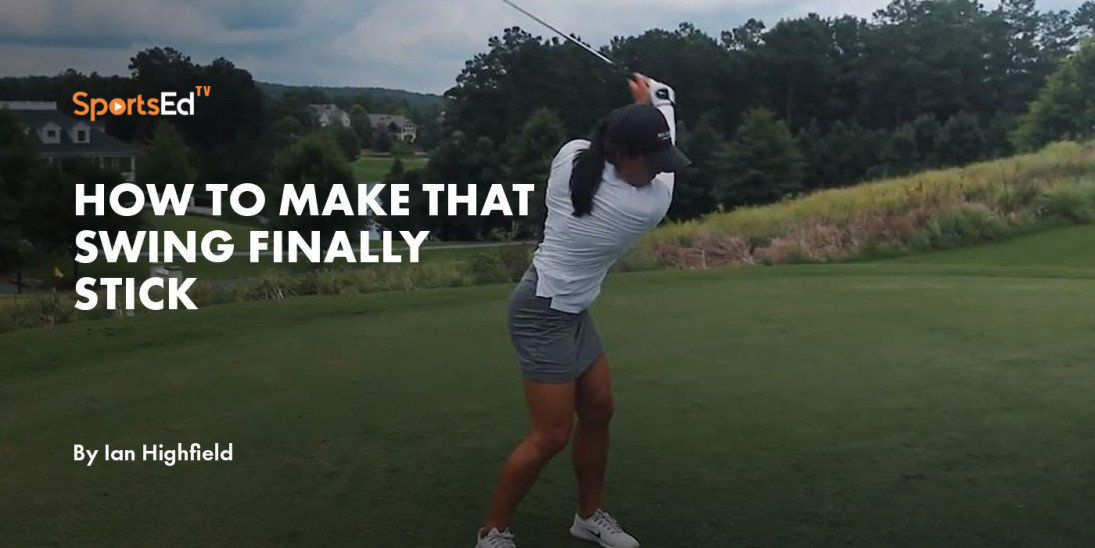Golf
Welcome and thanks for visiting...

How to take your range game to the golf course

SportsEdTV Golf is committed to bringing athletes, coaches, and parents pro-level golf education videos for FREE. All levels, anywhere, anytime. Check out our full instructional library and sign up to join our golf community!
Let’s use a Tiger Woods analogy to get you in the right frame of mind for training in a way that will lead to higher performance where it matters the most, the golf course.
In 1996, Tiger Woods signed a preposterously lucrative sponsorship deal with Nike. As he put pen to paper and wrote his signature, his body was enabled by what is known as a generalized motor pattern. Motor programs allow the brain and body to connect and produce a coordinated set of movements involving both voluntary and reflex actions, like signing your name.
Now imagine if the paper that Tiger signed his name on was replaced by a chalk board or a sand pit (unlikely we know) but these scenarios would result in Tiger having to adapt his generalized motor pattern that he has created over the years, to the different conditions of chalk and sand.
Over the years (even pre-1996,) it is likely that Tiger has signed his name thousands of times and had an extremely effective generalized motor pattern for this activity, making it easier for him to adapt.
Previous signings on brims of hats, golf balls, head covers, napkins in bars and other uneven surfaces that it’s best not to think about, would also give him a data bank of past experiences to which he could refer, making the success of crossing the ‘T’ and dotting the ‘I’ a simple task.
Tiger's golf is no different. Over the years, he has hit thousands and thousands of balls and developed a highly effective generalized motor pattern. He has also played on hundreds of different courses, in almost every condition imaginable, enabling him to ‘chunk’ information and therefore learn to adapt his generalized motor pattern.
Basically, Tiger’s vast experience allows him to adapt his swing to almost any situation – not because he’s spent all that time mastering his technique, but because he spent it experiencing, learning and retaining an encyclopedia of tournament scenarios.
If you want to be able to Turn On your Motor, like Tiger does we need to practice the total process of hitting a golf shot...
This can be driven by what we call contextual practice...
The goal of practice is not to develop the perfect repeatable swing, it is to develop a generalized motor program (your swing) that you then must learn to adapt to the environmental demands of the golf course.
Golf is, after all, a problem-solving task in which the problem involves sending the ball from point A toward point B.
The solution to the problem involves a process that requires situational awareness, perception, movement planning, retrieving a motor program and adapting the motor program from memory – all before the swing is executed.
During competitive play a golfer has to do all of this while adapting to the demands of the environment (the wind or an uneven lie being prime examples) not to mention the stresses contributed by the competition and its outcomes. And these stresses are all relative, whether it’s a putt for your first major victory, tour card or the lowest net score in the Sunday medal, that stress response is still going to fire.
You’ll be pleased to hear that the practice tasks detailed in this article is going to take all of this knowledge and theory we just shared and turn it into something you can apply.
Now, in addition to the spacing, variability and challenge that you learned about in my previous article (insert link) we’re going to begin to establish your chunking process through recreation and simulation of REAL competitive golf situations – ultimately helping you adapt your generalized motor pattern to the demands of the golf course and outcome pressures. You’re going to love it. Why, because this will help you finally take your range game to the golf course.
Practice Task 1 – Golf Range
12 point challenge
Rules:
12 shots, 1 point for each successful execution
- Attempt to hit a driver into hit 45 yards wide imaginary fairway
- Attempt to hit a 9 iron to within 40 feet of a target
- Attempt to hole a 3-foot putt
- Attempt to hit a driver into hit 40 yards wide imaginary fairway
- Attempt to hit a pitching wedge to within 30 feet of target
- Attempt to hole a 6-foot putt
- Attempt to hit a driver into hit 30 yards wide notional fairway 8.
- Attempt to hit a sand wedge to within 25 feet of target
- Attempt to hole a 9-foot putt
- Attempt to hit a driver into hit 35 yards wide imaginary fairway
- Attempt to hit a 8 iron to within 45 feet of a target
- Attempt to hole a 12-foot putt
Scoring System:
1 point for every successful execution
Note how the 12 shots are broken up into 4 distinct segments, “holes”, which require the player to use driver, iron and putter just as they would on the course.
The exercise becomes progressively more challenging as the fairways narrow and the putts increase in length.
This challenge embraces, spacing, variability and challenge as discussed in my previous article.
https://linktr.ee/iainhighfield - Click here to download a FREE eBook that details more golf range practice tasks like this one
Practice Task 2 – Golf Course
The Sharp Shooter
Get ready to fire some birdies in competition through experiencing it in practice.
This game is designed to help you with outcome stress when using the driver and sharpen your scoring wedges
Rules:
Hit the tee shot as normal with the goal of hitting the fairway.
From there, pick up your tee shot and move it to between 50-90 yards, keeping it in the same cut of grass as where your tee shot finished.
To earn an additional bonus ball for your approach shot, your drive must have:
Intermediate level – hit the fairway or within 1 club length of fairway
From 50-90 yards play your approach shot and the bonus ball if you earned it.
Select your best ball and play out.
Scoring system:
Make as many birdies as you can in 9 or 18 holes OR record your number of strokes for 9 or 18 holes and continually be trying to improve this outcome.
Watch these instructional videos of golf course challenges.




